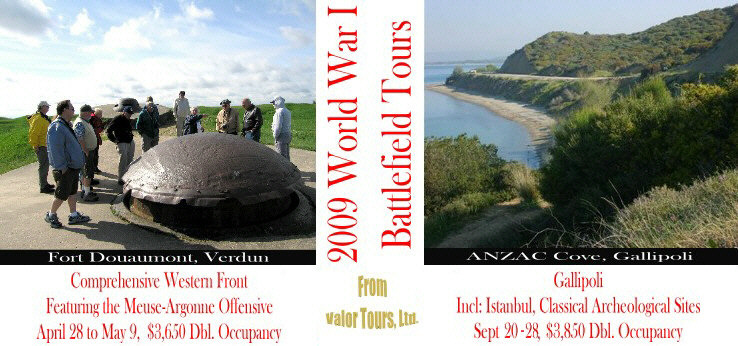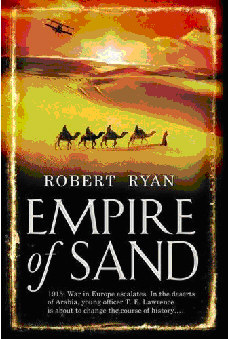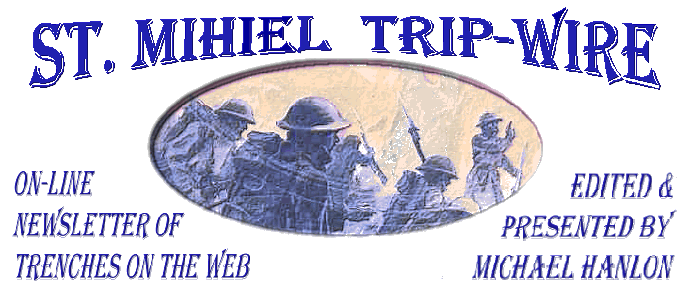
TRENCH REPORT: Merry Christmas and Happy New Year to all our readers. With our annual holiday greeting done, I can now share THREE big news items with you. (1) For the first time since 1994 The Great War Society and the Western Front Association - U.S. Branch are going to join forces to conduct a national seminar, September 11-13, 2009 at the National World War One Museum in Kansas City. We will be letting you know when more details are available in the Trip-Wire Calendar section in the right column. . .(2) The same team that produces the St. Mihiel Trip-Wire and Over the Top magazine has been invited to edit and improve the quarterly journal of The Great War Society, Relevance. As you will read below, our first 48-page effort has been completed and can be downloaded at the Society's website (also being upgraded) for free in a one-time blatant recruiting ploy (link). . .(3) I have made a decision about whether to shift the Trip-Wire from a newsletter to a blog. We are going to keep it basically the same but add "blog" to the masthead, thus enabling us to be listed in search devices. Look for some new graphics in 2009 and at some point--to spread my workload (a bigger concern due to taking on Relevance)--I might try posting half at mid-month and the remainder on the last day of the month. We will wait,though, on that option. Many thanks to the 43 readers who took time to respond to my request for advice on this matter. By the way, next month's issue may be a few days late, I plan to be at the Rose Bowl New Year's Day to watch my alma mater, Penn State, play the Pacific 10 representative. If you have any leads on accommodations or face-value (non-scalped) tickets, I'd be delighted to hear from you. (email) On to 2009! MH
This Month's Internet Feature
Commemorations of
the Armistice
90th Anniversary of War's End Remembered
Events in Europe (Includes Related Stories and Video)
Story of Britain's Unknown Warrior
The BBC--Guided by Trip-Wire Columnist Christina Holstein--Visits Verdun
(Also see Christina's Monthly Column below)
U.S. Remembers Its WWI Veterans (Slide Show)
Last Doughboy Frank Buckles Featured in Smithsonian Magazine
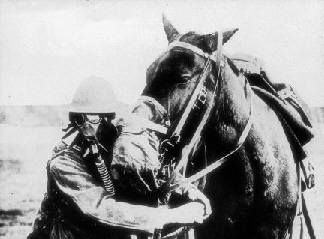
Comparative Gas Masks
Found at the New Life Magazine Archive (link)
New at Our Own & Our Friends' Great War Websites
Click on Title or Icon to Access
|
A Special Commendation To: The George S. Patton, Jr. Museum for Their WWI Educational Slide Show:
At Great War Society Sites
Take a look at the progress being made on the Society's new website currently being upgraded by master web designer Nic Solberg. There you can join or renew membership on-line and access all of our content. You can also download the latest issue of the quarterly journal Relevance that was produced by your Trip-Wire team. MH
At the WFA-USA
|

One of the unappreciated achievements of the Great War was the unprecedented transport of the huge American Expeditionary Force across the ocean. Before embarking for France, President Wilson addressed this in his State of the Union speech on December 2, 1918:
A year ago we had sent 145,918 men overseas. Since then we have sent 1,950,513, an average of 162,542 each month, the number in fact rising, in May last, to 245,951, in June to 278,760, in July to 307,182, and continuing to reach similar figures in August and September, in August 289,570 and in September 257,438. No such movement of troops ever took place before, across three thousand miles of sea, followed by adequate equipment and supplies, and carried safely through extraordinary dangers of attack.
 Our Reader Charles Krohn of the American Battle Monuments Commission Spends Armistice Day at America's Forgotten AEF Memorial, Washington D.C.
|
Merry Christmas from the Trip-Wire Staff
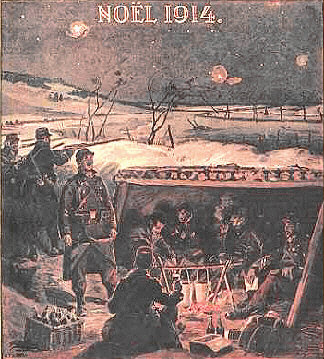
Cover, La Guerre Mondiale, Dec. 1914
GREAT WAR 2009 EVENT CALENDAR
|
Western Front Association-U.S.A. &
The Great War Society
Combined 2009 Annual Seminar,
September 11 - 13, 2009
National World War I Museum
Kansas City, Missouri
The wide-ranging and compelling theme for the seminar combines the original seminar ideas for both organizations: "Technology, Treaties and the War: From 'Tin Hats' to Tanks and 'Top Hats' to Territories." Registration forms, fees and further information will be forthcoming. Check back here or at the organizations' websites for details. (link)
|
Western Front Association
U.S. Branch Chapter Meetings
Check for Your Region
Regularly Updated (details)
|
Great War Society Monthly Chapter Meetings
Berkeley, San Francisco and Palo Alto, CA
Regularly Updated (details)
|
Send additions/corrections:
Email Response
|
 Memorable Event
Memorable Event
|
Woodrow Wilson
Arrives in Europe
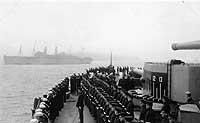
USS George Washington Carrying the President Arrives at Brest
December 13, 1918
Click on Image to Learn More
|
|
Our film reviewer, Andrew Melomet of Andy's Nickelodeon has spotted three new WWI films on their way, although little has been announced yet about their distribution plans for the U.S. market.
| One of the world's most beloved and most maligned foods is credited to a Great War veteran. Originally assigned as an infantry officer to the U.S. 88th Division, Lt. Jay C. Hormel was assigned duty with Ice Plant Company #301 in the the Services of Supply that put to use the experience he had gained from the family meat packing business. With his commander, Lt. Hormel devised a plan for saving 40% of the space used to ship meat to Europe by boning the cuts and freezing them. He was sent home to implement the successful plan and later applied what he had learned in the AEF at the family business, Hormel Meats, when he became its CEO in 1929. One product of his "bone and can" approach was the GI favorite of WWII, Spam. The best explanation for what "Spam" signifies is that it contains shoulder of pork and ham. The connection of Spam-the meat with Spam-the computer nuisance goes through Monty Python land where a highly repetitive song about the meat is an artifact.
|

. . .Situations will constantly arise when there is no officer or non-commisioned officer present with groups of men, and the men must realize that, in such a case, one man must assume leadership on the spot and the remainder act under his control.
British General Headquarters,
"Training Division for Offensive Action," 1916
In next month's OVER THE TOP magazine, we will present some of the writings of the greatest war correspondents who reported from the Distant Fronts.
|
End of the Year Collage
Some Photos We Want to Share
|

Clockwise from Top Left: Bruce Bairnsfather Plaque Near "Plugstreet" and Christmas Truce Site, Ypres Salient, Dedicated by His Biographers and Trip-Wire Readers Tonie and Valmie Holt; Two Friends: David Beer and Len Shurtleff at the Recent WFA-USA, Southwest Chapter Seminar Aboard the Last WWI Dreadnought, the USS Texas; On-Location Reenactment Last Year of the 1914 Christmas Truce; America's Last Doughboy, Frank Buckles, Meets with President Bush in the Oval Office
|
|
|
|
Page Two
|
|
|
Ireland at War
One of the perks of being a publisher is that I receive a lot of review copies of new books. The recent delivery of Our War: Ireland and the Great War, John Horne, ed., Royal Irish Academy, 2008, was accompanied by an interesting fact sheet.
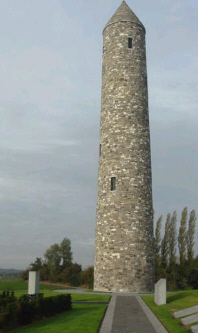
Irish Peace Tower, Ypres Salient |
- Over 200,000 Irish fought in the war for the British Army and over 35,000 died.
- The majority who served--even taking into account the 36th "Ulster" Division, which was formed from the exclusively protestant Ulster Defence Force--were Catholics.
- Recruitment was lower by percentage in Ireland than in England, Scotland or Wales, but this was due primarily to Ireland's higher proportion of population committed to agriculture.
- Irish immigration to America was halted in 1915, otherwise some of the participants in the 1916 Easter Uprising could have been in America.
- Due to the war, important improvements in nutrition and child care were implemented in Ireland.
- Because of war restrictions, the output of Irish breweries and distilleries was only half in 1918 of what it was in 1916.
|
|

|
Working with the BBC
By Christina Holstein
|

Christina on Camera with BBC Interviewer Robert Hall
I've not had the pleasure of working with TV or radio before this year, but the 90th anniversary of the end of the Great War brought me a number of unexpected opportunities. These included a Timewatch documentary for the BBC, which dealt with the last day of the war, and various BBC TV and radio features either taped or live which went out between 6th and 11th November. I was very impressed by the professionalism, calm and friendliness of the various teams that I worked with and fascinated to see how everything was set up, particularly how we were linked to the studio in London during the live broadcasts. Although freezing cold for the Timewatch filming last February, it was calm, sunny and bright for Armistice Day – against all odds in Verdun in November and totally different from 11th November 2007, when the fog was so thick that we couldn't see to the other side of the Ossuary car park.
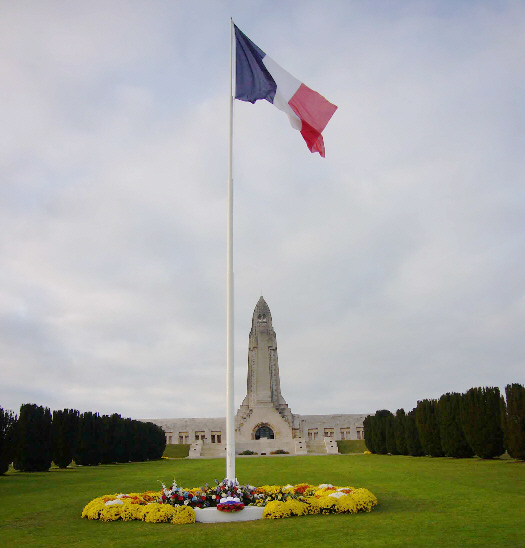
Wreaths Laid around the Central Flagstaff by the President of France, the Prince of Wales, the Grand Duke of Luxembourg and the Governor-General of Australia
On a "normal" Armistice Day there aren't many people about on the Verdun battlefield. Each year on 10th November the Eternal Flame is lit in the Ossuary after being brought to Verdun from the Arc de Triomphe in Paris by a relay of runners -- an event that would surely make headlines if it happened in Britain but which passes more or less unnoticed in France. On 10th November 2007 there were only a handful of people present for the flame ceremony, and that included the official party from Verdun city and the colour bearers. On the following day, cadets from a French military academy had a private ceremony in the Ossuary at 11 a.m., but without them things would have been very quiet -- just the colour-bearers again, a few officials, us and a little girl with an elderly woman with whose father, perhaps, had fought at Verdun. However, this year there were hundreds of people around during the weekend before Armistice Day, more than I have ever seen at Verdun even on a sunny Sunday in summer. On 9th, 10th and 11th November they were swarming around the Ossuary and the forts, and even when it was getting dark at the end of the day they were still pouring up the hill from the city to see what was happening.
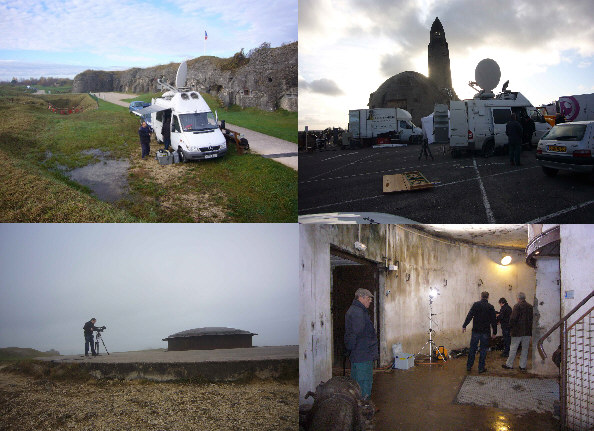
Television Comes to Verdun
When we had finished filming on 11th November I took the BBC team into Fort Douaumont for a whirlwind visit. We emerged to a pink sunset and a rising moon and walked across the top of battered fort in deepening twilight. I drove away wondering what the ghosts that inhabit the battlefield would have made of it all. I have stood at the Ossuary in the dark to watch the moon rise and felt the cold ghosts swirling around, but this time all was still. Perhaps they were thinking that at last, after 90 years, people were starting to understand what had actually happened at Verdun. If so, I hope they were content.
Click here to see video excerpts of Christina's BBC presentations.
|


Indian Lancers on the Somme, Illustrated War Record, July, 1916
Click Here to Visit War in a Different Light
|
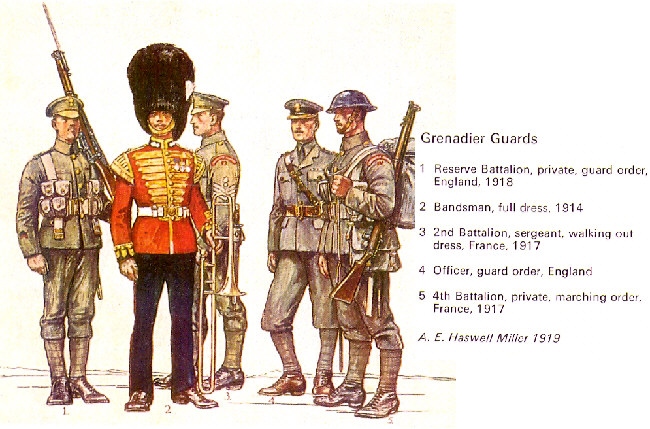
Wartime Uniforms of Britain's Grenadier Guards
From the Collection of MG Tom Jones
|
Big Doings at the Sgt. York Site in the Argonne Forest
Reported by
Lt. Col. Doug Mastriano, U.S. Army
Ninety years ago a hero left his mark in the Argonne Forest.
On October 4th a ceremony to honor the heroism of Sergeant Alvin York was conducted at Chatel-Chéhéry, site of his famous deed. The ceremony was a huge success. God blessed us with terrific weather, and there were over 600 people at this event, with delegations of soldiers from four different nations totaling about 100, 200 Boy Scouts, and a lot of media representatives. The event commenced at the Chatel-Chéhéry town hall and then moved to the battlefield to dedicate two monuments at the very location where York earned the Medal of Honor on October 8, 1918. This also included a ribbon cutting ceremony to officially open the Sergeant York Historic Trail.
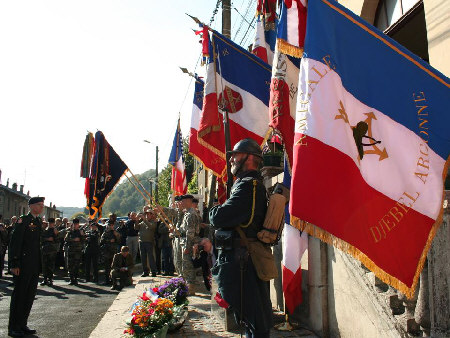 |
Opening Ceremony at the Chatel-Chéhéry Town Hall |
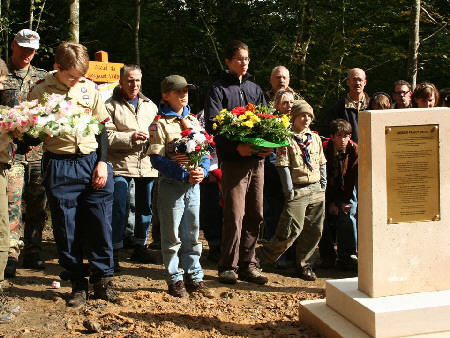 |
Dedication of the Monument at the Site of the Bayonet Attack |
There were a lot of fantastic aspects of this event, but one of the biggest highlights was having three generations of Yorks at the event (son, grandson and great-grand daughter), who, with the 82nd Airborne Division, unveiled and dedicated the battlefield monument. This monument and an information kiosk are located where my team of researchers discovered the shells from York's .45 Colt semiautomatic pistol and where he fought off German Lt. Fritz Endriss's bayonet attack.
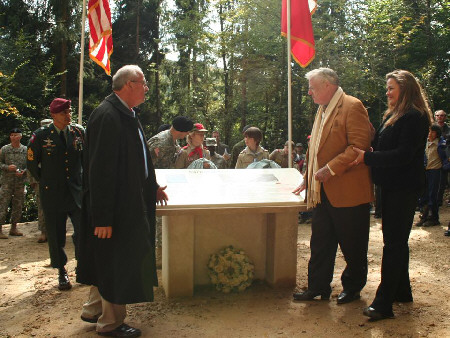 |
York Family Members Honored: (l-r) Son George York, Grandson Gerald York and Great-Granddaughter Deborah York |
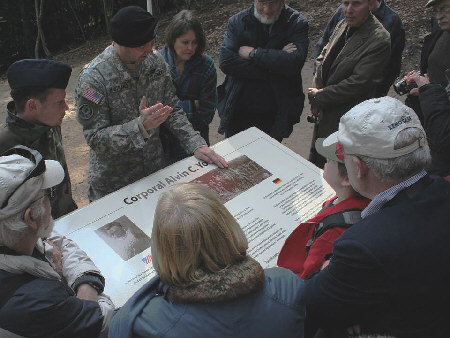 |
Informational Kiosk on the Historic Trail |
The ceremony included the singing of several of Alvin York's favorite hymns: "Rock of Ages," "Battle Hymn of the Republic," and "Amazing Grace." It is our prayer that this event honored the memory and faith of York. For more information on the Historic Trail and our on-site research please visit our website at: (www.sgtyorkdiscovery.com).
|
|
Subscribe to Our On-Line Magazine
|
|

|
|
|
Page Three
|
|
|
2009 World War I Tours Led by
Trip-Wire Editor Mike Hanlon
Click on image to request a brochure from greatwar@earthlink.net
|
|
| Gift Suggestions for WWI Students
|
Coffee-Table Books in Time For Christmas.
Recommended by Len Shurtleff, Editor of Len's Bookshelf (link):
Battlefields of the First World War, Peter Barton, Constable, 2008, 352 pages, photos, maps, DVD, ISBN 1 84529 884 5, £30 hardcover, from Amazon.com. Some 300 contemporary photo panoramas, including 60 on the accompanying DVD covering the length of the BEF front.
The Somme, Peter Barton, Constable, 2006, 192 pages, ISBN 1 8452 9399 1, £25 hardcover and Passchendaele, Constable, 2007, 468 pages, ISBN 1 8452 9422 X, £30 hardback. Hundreds of photos taken at the front.
In Memoriam, Robin Cross, Embry Press, 277 pages, ISBN 978 0 0919 2530 7, £20 hardcover. Issued in conjunction with an Imperial War Museum exhibition honoring those who fought. Chronological account with digressions into specific aspects of the conflict. Lavishly illustrated with period photos and drawings.
Shots from the Front, Richard Holmes, HarperPress, 2008, 256 pages, photos, index, ISBN 0 0072 7548 X, £20 from Amazon. A photo essay history of the Great War on many fronts, including Gallipoli and Mesopotamia.
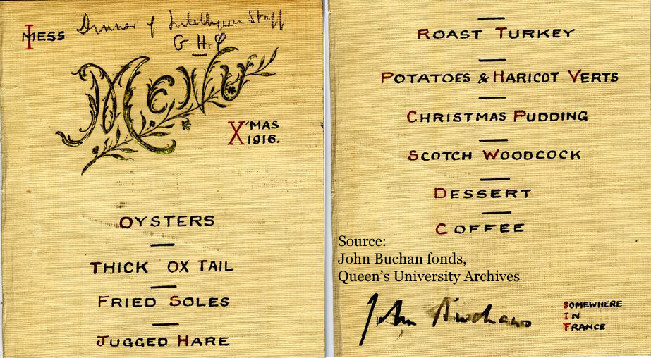
Famous Author John Buchan (The 39 Steps) Enjoyed This Protein-Rich Christmas Dinner with the Intelligence Staff at British Army General Headquarters in 1916
|
 |
Robert Ryan's Novel
Empire of Sand
Reviewed by Anne Steele
|
I presume virtually everyone reading this review is familiar with the story of "Lawrence of Arabia", T. E. Lawrence, the brilliant illegitimate son of an Irish nobleman, whose education led him to the Middle East for archeological reasons, who became valuable to British Intelligence in Cairo analyzing maps and interrogating prisoners, and who was the major figure in the Arab Revolt against the Ottoman Empire.
This is only the background for the adventure story told in this novel. The author wanted to fit in a story about Lawrence during a period in which there is little popular knowledge: that time before he led the Arabs in the Hejaz. This period is one about which only intensely interested Lawrence scholars and aficionados know much, and even they will acknowledge that there is much that hasn't been revealed to this day.
The author wanted to write a novel about Lawrence during his period of adventure. Lawrence's early life was interesting but not very adventurous, even considering his walking tour around the Middle East alone. His life after the war was out of the ordinary. Some of it has been told in movies such as A Dangerous Man, about the 1919 Versailles Conference, during which Lawrence aided Feisal in an attempt to nullify much of the Sykes-Picot Treaty, and in the book Dreamers of the Day by Mary Doria Russell, a novel that takes place during the Cairo Conference of 1920, at a time when Lawrence was an advisor to Churchill on the details of the division of the Middle East. After that, Lawrence voluntarily entered a status of anonymity that lasted the remainder of his life.
As a foil for his story, the author found Wilhelm Wassmuss, a blond, blue-eyed German, with a penchant for self-promotion and a predilection for wearing native garb out in the desert. He loved the tribesmen of the Middle East and encouraged them to revolt, telling a few fibs along the way. A lone biography came out in 1935, Wassmuss: The German Lawrence, by Christopher Sykes. He has been called the German "Lawrence of Arabia" or "Wassmuss of Persia." Described as one of the world's first covert action operatives, he was a German government official who was commissioned to stir up the tribes in Persia in opposition to Britain. He was the official agent of "Hajji" Wilhelm, more commonly known as the Kaiser. With this real-life character we get a 1915 adventure in Persia, a land on which there is no evidence that Lawrence ever trod.
The story is full of characters who are well known from the period -- Kitchener, Allenby and Gertrude Bell. All are interested in developments in Persia, given Britain's newfound need for secure oil reserves for her navy. The story unfolds with murders by hideous means, arms deals, subversion, subterfuge, disguise, battle scenes and plot twists that keep the reader turning the page. Certainly this is a good read for anyone interested in the period. Be assured, this is a work of fiction. Even knowing that, the book is good enough to leave you thinking that it could have happened.
|
|
World War I Headlines
in the
21st Century
|
|
L'INSTINCT DE L'ANGE
By Andrew Melomet
Originally released theatrically in 1993, L'Instinct De L'Ange has finally come out on DVD in the United States as Angel's Wing from Koch International ($24.98). Written and directed by Richard Dembo, Angel's Wing tells the story of Henri (Lambert Wilson) a rich Frenchman who after recovering from tuberculosis tries to join up at the start of the World War. Turned down by the army, he learns to fly and becomes a pilot with the Aéronautique Militaire. He's not very good and continually crashes his aircraft until taken under the wing of a more experienced pilot, Ernest Devrines (Framcois Cluzet). Once Henri becomes adept and able killer he rackes up a formidable score of German aircraft. The more successful he is in killing the enemy, the more he is shunned by his squadron mates who come to superstitiously fear him as an emissary of death.
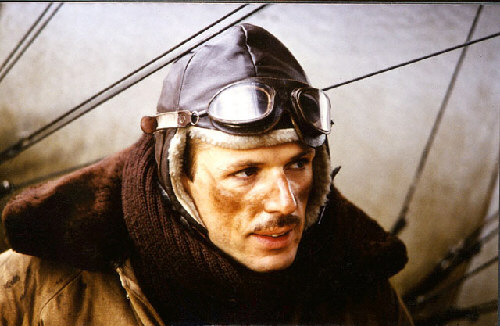
Promotional Image from the Film
L'Instinct De L'Ange is loosely based on the life of Georges Guynemer and his relationship with his mentor, Jules Vedrines. Guynemer had been sickly as a youth and was also rejected from military service before training as a pilot. He earned a bad reputation by crashing several aircraft during his training. Eventually, the famed long-dstance pilot Jules Vedrines became his mentor. Guynemer was lost in combat in September 1917. Vedrines flew secret missions, often landing agents behind enemy lines and survived the war, but lost his life in 1919 while preparing for a non-stop flight from Paris to Rome.
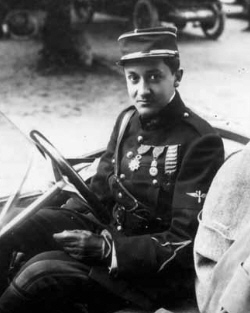
Georges Guynemer |
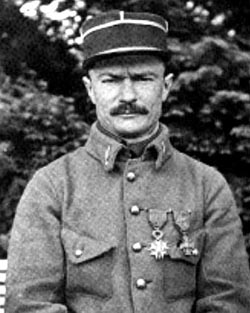
Jules Vedrines |
The film has a superb cast with Lambert Wilson as Hernry, Francois Cluzet as Devrines and Jean-Louis Trintignat as Colonel Edouard, the squadron commander. Helene Vincent is Henry's mother and Marianne Denicourt, Sandrine Kiberlain and Marie Trintignant are potential love interests for the pre-occupied Henry. The musical score by Gabriel Yared is haunting, and the cinematography by Renato Berta effectively captures the introspective mist-shrouded pre-flight mornings experienced by Henry and his fellow fliers.
Unfortunately the technical quality of the DVD from Koch leaves much to be desired. While the title is wide-screen, it is not anamorphic and must be 'blown-up' to fill widescreen televisions. The subtitles contain misspellings and grammatical errors, and there are no extras, not even a trailer.
What makes the film especially interesting for First World War aviation buffs is the extensive use of aircraft from the Amicale Jean-Baptiste Salis Flying Museum and the European Memorial Flight. When you rent or buy this DVD watch for the Bleriot XI, the Morane Saulner H, MS.138 and A.1 You'll see a SPAD VII and a Breguet 14. The Fokker Dr.1, Albatros C-2 and S.E.5s are fine replicas. The flying sequences are very well-done and I can recommend Angel's Wing just to see the aircraft.
|
|
| With this anniversary issue, I'm going to cease trying to remember and thank each individual who contributes to the new Trip-Wire. I've been forgetting too many of you. Forgive me. I get tips on the telephone, via email, at meetings, the supermarket, in the regular mail and from all our regular and periodic contributors. Thanks to each and everyone of you. Until next month, your most appreciative editor, Mike Hanlon. |
SUBSCRIBE TO THE TRIP-WIRE
(Or send it to a friend)
(Or send us a comment on the TRIP-WIRE)
CLICK HERE TO CONTACT US VIA EMAIL |
For further information on the events of 1914-1918
and membership information visit the Directory Pages of:
|
|
| |








 Memorable Event
Memorable Event














